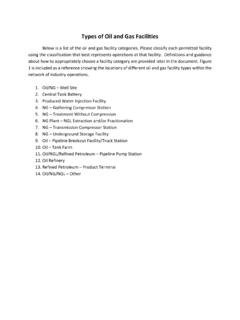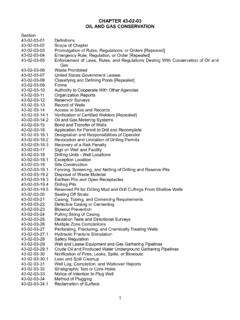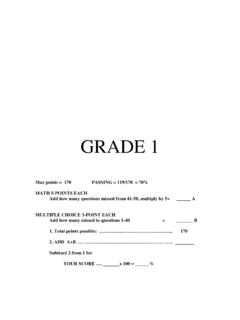Transcription of Underground Injection Wells for Produced Water Disposal
1 Underground InjectionWells For Produced Water Disposal Rick McCurdySr. Engineering Advisor Chemicals and Water ReclamationChesapeake Energy Corporation6100 N. Western Avenue Oklahoma City, OK 76118 NYSE: CHK3 AgendaHistory Program OversightWell ClassificationsClass II WellsReclamation / Disposal CombinationsSummary4 History1930sOilfield brine Disposal (Texas)EOR Injection1940sOil refineries inject wastes1950sDeep well Injection of chemical wastesState regulations for brine disposal1960sEarthquake attributed to deep well Injection in Colorado1stdocumented cases of contamination in potential sources of drinking water5 History1970sWaste spilling from an abandoned oil well traced to paper mill Injection wellSDWA gives EPA authority to control Underground injection1980sUIC regulations 5 well classes Layout requirements for States to assume primacySDWA amended to allow for existing oil and gas programs to regulate Must be effective in protecting USDW Must include UIC program componentsHSWA to RCRA Hazardous
2 Waste Injection more stringent No migration petition 10,000 years or rendered non-hazardous by reaction with surroundings6 History1990sClass V management strategy1stInternational symposium on deep well Injection (CA)2000 to presentEnergy Policy Act (2005) excludes hydraulic fracturing from regulation under UIC programEPA initiates Study to Evaluate Impacts to USDW s by HF of CBM reservoirsGeologic sequestration of carbon dioxide (CO2)7 Program OversightPrimary Enforcement (Primacy)States / tribes may request if they can demonstrate ability to meet minimum EPA requirementsSome states / tribes share primacy with EPAW here neither of the above apply, EPA enforces UIC program through Region offices8 Primacy9 well ClassificationsClass IHazardous waste, non-hazardous liquids, municipal wastesInject under lowermost USDWC lass IIClass IIIE xtraction of minerals Salt, uranium, sulfurClass IVBanned (originally for hazardous or radioactive waste Disposal into or above a USDW)
3 Currently limited to authorized clean-up sitesClass VAll other wellsInject non-hazardous liquids into or above a USDWC lass VIGeologic sequestration of carbon dioxide (CO2)10 AgendaHistory Program OversightWell ClassificationsClass II WellsReclamation / Disposal CombinationsSummary11 Class II WellsApproximately 144,000 Wells in the in TX, CA, KS and OKCA, 26305IL, 7944KS, 16245NM, 4699OK, 11365TX, 49957WY, 4723 Others, 1920412 Class II Wells ~144,000 Class II WellsEnhanced Oil Recovery~80% of all Class II wellsWater Injection Wells (WIW) most common, but also includes Steam Injection Water - alternating - gas (WAG) Simultaneous Water and gas (SWAG) CO2injectionSalt Water Disposal ~20% of all Class II wellsUsed only for Disposal of fluids associated with oil and gas productionHydrocarbon StorageUsed to inject and remove liquid hydrocarbons from Underground storage ( salt caverns)Strategic Petroleum ReserveMore than 100 Wells in the (< of Class II)
4 13 AgendaHistory Program OversightWell ClassificationsClass II WellsSalt Water Disposal Wells Selection well Construction Volume / Pressure Integrity Assurance Economics Pennsylvania / Texas ComparisonReclamation / Disposal CombinationsSummary14 Salt Water Disposal WellsSelectionNon-hydrocarbon bearing formation or an unproductive / depleted formationBarriers to USDWsArea ReviewPorosityPermeabilityLocation, location, location!15) Packer1) Surface Casing) Steel tubing(2) Surface Casing Cement3) Production Casing(4) Production Casing Cement) Plastic coatingChesapeake Barnett SWD ConstructionTexas Railroad CommissionMonitoring & TestingDrilling and Completion Casing* Cement* Tubing* PackerTesting Prior to Service Cement Bond Log Pressure TestingOperations Continuous Monitoring* Annual Integrity Testing*Reporting Prior to Placing in Service Monthly Injection Date Pressure Volume*Areas in which Chesapeake exceeds Railroad Commission of Texas standards(5((6((716 Volume and PressureStep rate tests utilized to confirm the rate and pressure required to break down or fracture the targeted formationFracture gradient established based on step rate tests and instantaneous shut-in pressure (ISIP)
5 Wells are typically permitted for a pressure and ratethat does not exceed the frac gradient when pumping the typical brine for a known area17 Wellbore IntegrityPrior to serviceCement bond / cement evaluation logsPressure test casingDuring operationUIC minimum requirements Mechanical integrity test every 5 years Monitor pressure annuallyMany States have more stringent requirements Texas Monitor and report mechanical integrity (H5) minimum once every five years, but permit may specify more frequent Monitor Injection pressure monthly & report annually (H10)18 EconomicsCHK SWDT ypically < $ / barrelCommercial SWD$ - $ / barrelSupply and demandTrucking$ / barrel / hour (average)SWD s plentiful (TX) $ - $ / barrelSWD s scarce (PA) $ $ / barrelSalt Water PipelinesMore efficient than truckingReduces traffic and road wear19 Pennsylvania / Texas ComparisonPennsylvania8 Class II saltwater Disposal (SWD) Wells Oriskany3 Oriskany / Huntersville2 Balltown1 Gatesburg1 Mine Void1 Texas~12,000 Class II SWD wellsTarrant County 10 SWD Wells All Ellenburger2020 Brentwood SWD SiteClose-up of Brentwood SWD well in East Fort Worth.
6 21 Disposal CapacityMann SWD Cleburne, TexasEllenburger Formation~26,000 barrels per day (BPD) million barrels per yearPennsylvania SWD sOperatorBPDC olumbia700 EXCO142 CNX5,000*Range665 XTO**120 Cottonwood900 EXCO140 Dominion1,0008,667* - Mine void ** - Reported as recently plugged22PA ExperiencePA SWD TargetTrenton / Black RiverSE of Towanda, PATargeted total depth (TD) 14,300 Budgeted - $3 MMFinal Spend - $ 7 MMLimited fluid capacityWell TA d Permanent bridge plug @ 12,000 23 Water ReuseLack of Suitable Disposal Infrastructure / Capacity in PA Originally Resulted in Produced Water Being Trucked (or railed) to Ohio and West VirginiaAqua RenewFiltration and reuseCentral filtration sitesBermed and linedSteel tanks for storage of all Produced brineBenefitsDecreases fresh Water demand by 10-15%~52,500 less truck road miles per well for Water disposalCO2emissions reduced by ~88 metric tons per well 24 AgendaHistory Program OversightWell ClassificationsClass II WellsReclamation / Disposal CombinationsSummary25 Brentwood SWD Site26 Reclamation / Disposal CombinationsEconomics can work in areas where Disposal capacity is limitedWater quality (total dissolved solids - TDS)
7 Greatly influences economicsCapacity multiplier particularly with relatively low TDS brine Concentrated brine requires less energy for disposalEvaporative systems no backhaul of treated water27 AgendaHistory Program OversightWell ClassificationsClass II WellsReclamation / Disposal CombinationsSummary28 SummaryThe Oil and Gas Industry Has Utilized Underground Injection of Brine Since the 1930 s and Class II UIC Wells Currently Inject Two Billion Gallons of Fluid Per Day For Enhanced Oil Recovery, Disposal and Used Exclusively To Dispose of Fluids From Oil and Gas Production Account For 20% of the 144,000 Class II Wells in the Disposal in Class II Wells Is Safe, Environmentally Sound and is the Most Economic Option in Most Areas of Limited Disposal Capacity or Where Water Resources Are Stressed, Reuse of Produced Brine is Proving To Be an Effective Alternative To Underground Injection Wells For Produced Water DisposalRick McCurdySr.
8 Engineering Advisor Chemicals and Water ReclamationChesapeake Energy Corporation6100 N. Western Avenue Oklahoma City, OK 76118 NYSE: CHK Underground Injection Wells f or Produced Water Disposal Rick McCurdy Chesapeake Energy Corporation The statements made during the workshop do not represent the views or opinions of EPA. The claims made by participants have not been verified or endorsed by EPA. Introduction The Oil and Gas Industry first utilized Underground Injection as a means of disposing of the naturally occurring brine that was often Produced along with crude oil and / or natural gas in the 1930 s. In 1974, the Safe Drinking Water Act required the Environmental Protection Agency (EPA) to set minimum requirements for the brine Injection Wells utilized by the Oil and Gas Industry along with numerous other Wells used for Disposal of various hazardous and nonhazardous wastes.
9 These requirements are generally referred to as the Underground Injection Control (UIC) program. Since inception of the UIC program, Class II Wells (those Wells classified for Injection of oil and gas liquids including oilfield brine Disposal Wells ) have safely injected over 33 trillion gallons of oilfield brine without endangering Underground sources of drinking Water (USDW). History of Underground Injection During the 1930 s, oil producers first began disposing of the brine Produced in conjunction with crude oil back into the same formation from which it had been extracted. In this same decade, the practice of injecting Produced brine into a formation in order to push crude oil to an adjacent producing well was initiated, thus starting the practice of enhanced oil recovery (EOR).
10 In the 1940 s, oil refineries began using deep well Injection for Disposal of refinery waste and several chemical plants followed this trend a decade later. As the practice of brine Disposal using deep well Injection continued to grow, many states began implementing regulations for Disposal of oilfield brine in the 1950 s. In the 1960 s, documented cases of groundwater contamination associated with the Underground Injection of waste began to surface. Most notably, a waste Injection well at the Hammermill Paper Company in Erie, Pennsylvania suffered a casing failure and pulping liquor escaped into the surrounding ground and into Lake Erie. Though never conclusively determined, a black















